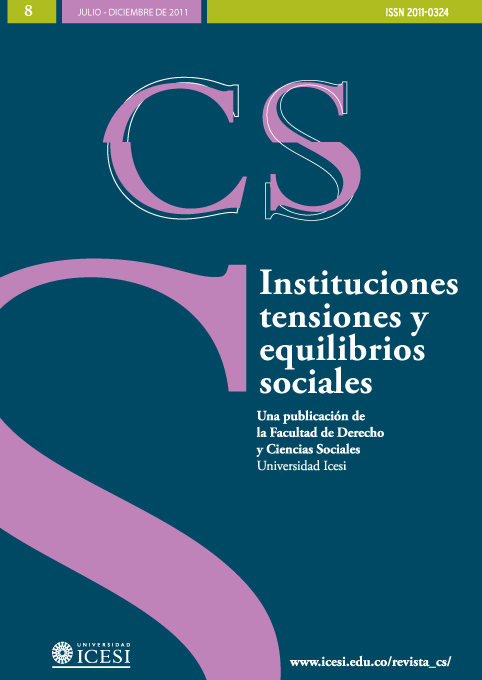Presencia de las instituciones en los enfoques del institucionalismo económico: convergencias y divergencias
DOI:
https://doi.org/10.18046/recs.i8.1130Palabras clave:
Institucionalismo, Instituciones, Neoinstitucionalismo, Nueva economía institucionalResumen
Existe un renovado interés en el estudio de las instituciones y su incidencia en la economía. El análisis de las instituciones engloba un conjunto de perspectivas, siendo las más relevantes los puntos de vista de Thorstein Bunde Veblen, Douglas North y Oliver Williamson. El objetivo de este artículo es reflexionar sobre las convergencias y divergencias entre los enfoques de Veblen, North y Williamson; y, a partir de eso, proponer una categorización que precise las definiciones, métodos y tratamiento institucional de cada perspectiva. El propósito de esto es ayudar a clarificar el apelativo ¿institucionalista¿, así como entender los aspectos incluidos en cada enfoque.Descargas
Referencias
Ayala, J. (Ed.) (2004). Instituciones y Economía: Una introducción al neoinstitucionalismo económico. Distrito Federal, México: Fondo de Cultura Económica.
Catalá, F. (1996). Economía heterodoxa: Aportes recientes del institucionalismo. Serie de Ensayos y Monografías, 77.
González, J. (2009). Teoría del desarrollo económico neoinstitucional: una alternativa a la pobreza del siglo XXI. Distrito Federal, México: Miguel Ángel Porrúa.
Gandlgruber, B. (2010). Instituciones, coordinación y empresas. Barcelona, España: Anthropos/UAM–Cuajimalpa.
García, A. (2005). Nuevo Institucionalismo versus Neo–institucionalismo Económico: dos perspectivas diferentes de ver a la empresa. Economía y Sociedad, 10 (15), 17– 30.
García, A. Lara, A. y Taboada, E. (2004). La coordinación ''híbrida'' desde las perspectivas de Williamson y de Nooteboom. Análisis Económico, 19 (40), 101– 117.
Hodgson, G. (1998). The Approach of Institutional Economics. Journal of Economic Literature, 36, 166 – 192.
Hodgson, G. (2003). El enfoque de la economía institucional. Comercio Exterior, 53 (10), 895 – 916.
Landreth, H. y Colander, C. (2000). Historia del pensamiento económico. Distrito Federal, México: CECSA.
North, D. (1993a). Instituciones, cambio institucional y desempeño económico. Distrito Federal, México: Fondo de Cultura Económica.
North, D. (1993b). Desempeño económico en el transcurso de los años. Conferencia dictada por Douglas North, el 9 de diciembre al recibir el Premio Nombre de Ciencias Económicas. Citamos la versión mecanografiada de 11 páginas. Disponible en: http/www.eumed.net/cursecon/textos/north–nobel.htm
Obregón, C. (2008). Teorías del Desarrollo Económico. Distrito Federal, México: Pensamiento Universitario Iberoamericano.
Pulido, U. y Díaz, J. (2007). Evolución y principios de la teoría económica institucional. Una propuesta de aplicación para el análisis de los factores condicionantes de la creación de empresas. Investigaciones Europeas de Dirección y Economía de la Empresa, 13(3), 183–198.
Rutherford, M. (2001).Institutional Economics: Then and Now. Journal of Economic Perspectives, 15, 173–194.
Veblen, T. (Ed.) (2003). The Theory of the Leisure Class. Pennsylvania, Estados Unidos: Pennsylvania University State.
Williamson, O. (1989). Las instituciones económicas del capitalismo. Distrito Federal, México: Fondo de Cultura Económica.
Williamson, O. (1991). Mercados y jerarquías: su análisis y sus implicaciones antitrust. Distrito Federal, México: Fondo de Cultura Económica.
Williamson, O. (1993). Transaction cost economics and organization theory, Industrial and corporate change, 2 (2), 107 – 155.
Publicado
Número
Sección
Licencia
Derechos de autor 2011 Rosa Azalea Canales García, Patricia Mercado Salgado

Esta obra está bajo una licencia internacional Creative Commons Atribución-NoComercial 4.0.
© Derechos reservados de autor
El material de esta publicación puede ser reproducido sin autorización, siempre y cuando se cite el título, el autor y la fuente institucional.
El contenido publicado en Revista CS se distribuye bajo la licencia Creative Commons BY-NC 4.0 Atribución/Reconocimiento-NoComercial 4.0 Internacional.
Usted es libre de:
Compartir — copiar y redistribuir el material en cualquier medio o formato.
Adaptar — remezclar, transformar y construir a partir del material.
Bajo los siguientes términos:
Atribución — Usted debe dar crédito de manera adecuada, brindar un enlace a la licencia, e indicar si se han realizado cambios. Puede hacerlo en cualquier forma razonable, pero no de forma tal que sugiera que usted o su uso tienen el apoyo de la licenciante.
NoComercial — Usted no puede hacer uso del material con propósitos comerciales.












